Denmark
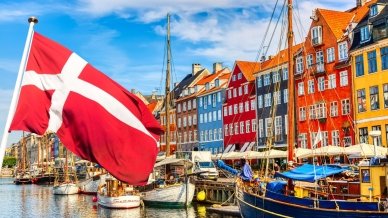
This red-and-white flag country in the Scandinavian south is the homeland of Hans Christian Andersen’s fairy tales, Skype, and Lego, and it is where the happiest people on Earth live.
Local traditions and lifestyles resemble the ones existing in other Scandinavian countries. The Danes drink as much coffee as their closest neighbours — the Swedes and Norwegians. However, Denmark has its own distinctive features that make it unique and unforgettable.

General Information
Denmark is the Kingdom, also known as the Danish Realm, including metropolitan Denmark, the Faroe Islands, and Greenland. The latter two are autonomous territories.
Historical Background
Modern Danes are the ancestors of ancient tribes that came to the island of Jutland from the southern suburbs of the Scandinavian Peninsula between the 5th and 6th centuries.
The Danes lived as tribes at first but, eventually, transformed their social system into a distinct hierarchy. The Germanic kings were in the highest position, and the bóndi took the lowest. The latter were the middle-class people who had the right to use weapons.
In the 10th century, the Danes were already actively settling the territories of England, Scotland, Wales, and France, taking part in campaigns of the Vikings. They managed to unite Norway, Denmark, and England into one state under the reign of Cnut the Great, which existed till his death.
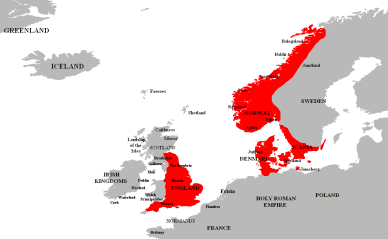
Cnut the Great's domains, in red
After the change of power, the country underwent long-lasting strife. The Danish princes were fighting for the throne without regard for the lives of their subjects. The rivalries stopped in the middle of the 12th century. It was the period when Valdemar the Great came to power and brought some stability, thwarted by the nobility from time to time.
In the 13th century, the area of the Kingdom extended at the expense of new territories annexed as a result of successful military campaigns. The German lands of Pomerania, Holstein, and Mecklenburg became part of Denmark for some time.
The beginning of the 14th century brought the union of two kingdoms — Norwegian and Danish. Princess Margaret, the daughter of Valdemar IV, married the King of Norway and, after his death, became the queen of the entire state. In a century, the royal residence was established in Copenhagen, which has remained the capital of Denmark till modern days.
In the 19th century, the Kingdom ceased to exist. Denmark lost another war against Sweden, ceding Norway. However, it managed to retain the Faroes, Greenland, and Schleswig-Holstein.
The Schleswig War caused new territorial losses. The Kingdom lost several duchies at once — Schleswig, Holstein, and Saxe-Lauenburg.
During that time, the monarchs implemented extensive reforms in the area of national politics. Denmark had been an absolute monarchy earlier, but in the 19th century, the multi-party system developed.
The reforms that continued at the beginning of the 20th century had an advantageous effect on the national policy, economy, banking sphere, and tax system.
Between 1939 and 1945, Denmark fought in WWII on the side of Hitlerite Germany. The Nazi regime took over the country, and thus persecution of Jews and dissenters followed.
After the War, Denmark was among the founders of the UN and NATO, and in 1973, it became an EEC member. It has been the EU member state but has not joined the eurozone.
Margarethe II has been the ruling monarch of Denmark since 1972.
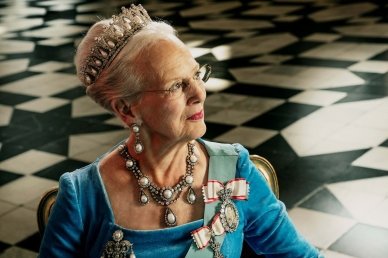
HM Queen Margrethe II is the second longest-serving monarch in Danish history
UPD: “On 14.01.2024, King Frederik X of Denmark ascended the throne following the abdication of his mother, Queen Margrethe II. Although Margrethe is no longer the reigning monarch, she will continue to be titled as Her Majesty and may be appointed acting regent, according to the Danish Royal Household. This means that she will be able to act as head of state when King Frederik or Crown Prince Christian are unable to, for example, if they are overseas.”
Geography and Climate
Denmark is located in the south of Scandinavia on the Jutland peninsula and occupies the islands of Funen, Zealand, Bornholm, and others.
It has marine borders with Germany, Norway, Sweden, and the North and Baltic Seas.
Climatic conditions of this Scandinavian country are not absolutely comfortable because winter here is often mild and rainy while summer is usually cold. However, the biggest trouble is the strong winds blowing almost all the time.
Language and Currency
The official language in Denmark is Danish, but almost all adult citizens speak English well. The total population is 5.8 million people (almost the same as in Finland). Though the country is considered the most populous in the Scandinavian region, most islands are still uninhabited.
The majority of the population are Lutherans. The Danish krone (DKK) is the official currency, and the DKK-USD exchange rate is 6.596:1.
Directions
There are various options for getting to Denmark. Those who travel from other continents will definitely choose trips by plane as they are the most reliable, convenient, and quickest ways.
The major airports in Denmark are the Copenhagen Airport, Billund, Aalborg, and Aarhus. As the main international airport in the country, Copenhagen serves such airlines as Aegean Airlines, Air Baltic, Air Canada, Atlantic Airways, Lufthansa, EasyJet, Qatar Airways, Ryanair, and many others.
European citizens may also travel by train, coach, or ferry as there is a well-developed network of international train and coach routes, ferry and cruise services.
Holders of biometric passports do not need a visa if they plan to stay less than 90 days. Those travelling to Denmark as students or employees should apply for a special visa.

Accommodation
The Danish hospitality industry includes more than a thousand hotels of various star-rating and pricing. Almost half of them are Horesta members, which is the organisation that has united the country’s hoteliers for providing high-quality services.
Horesta membership is a so-called quality certificate that guarantees absolutely clean and cosy rooms with a complete set of amenities necessary for a comfortable stay.
The network hotels are classified according to the five-star scaling. The obtained star rating always corresponds to the actual conditions. In Denmark, even the two-star and budget-friendly hotels are spacious, well-kept, comfortably furnished, and comply with sanitary requirements.
The other part of Danish hotels belongs to the Hotel Garni category. This network successfully functions within Europe (Germany, the Czech Republic, and other countries).
Garni hotels are economy-class accommodation that corresponds to the rating of one, two, and three stars. Though the range of services is rather limited, the hotels are the value for money. However, the guests should think about their breakfast in advance as there are no restaurants in the Garni network.
The other hotel type in Denmark is a SPA and wellness centre, usually chosen by families with children. The rooms resemble urban flats with kitchens where guests can cook by themselves. Such suites are spacious so that families can feel comfortable. Apart from the standard facilities, wellness centres often offer swimming pools, children’s playgrounds, and sports grounds.
- OM HOUSE- Bed & Breakfast is a budget-friendly, one-storey hotel in Nykøbing Falster that overlooks beautiful landscapes and welcomes its visitors with cosy rooms in the old country house style. Guests are also offered massage and acupuncture, a free car park, and Wi-Fi. The hotel is for non-smokers.
- Zleep Hotels is a two-star hotel in Aalborg that offers automatic check-in and Swedish Smorgasbord. The rooms are clean and cosy.
- Steel House Copenhagen is a three-star hostel in Copenhagen, not far from Saint George’s Lake, a 10-minute walk from Tivoli Gardens. Clients can enjoy comfortably furnished rooms, lounge area, shared kitchen, and laundrette. There is also a cafe, a gym, and free Internet access.
- Homelike is a hostel in Aarhus. There are rooms with kitchenettes and dishware. Besides, the guests can also use a laundrette, a free car park, and high-speed Internet access.
- Copenhagen Downtown Hostel is a cheap accommodation in the capital city. There are separate bathrooms, air-conditioning, Wi-Fi, and a bar in the lobby.
Renting accommodation in Denmark costs a lot. The prices vary by city (the bigger the city, the more expensive the apartment), remoteness from the centre, and other details. For example, a three-room suite rental in Copenhagen may cost €100-€1,200 a month, and a two-room lodging will cost €50-€700. This option is more suitable for those coming to Denmark to study or work. But if to rent an apartment jointly with someone else, it will be cheaper.
Places to See
Everyone comes here pursuing different aims. History fans want to see the monuments of architecture and museums, and party people aspire to feel the excitement of the nightlife of Copenhagen full of loud music, dances till morning, and a range of other extraordinary types of entertainment.
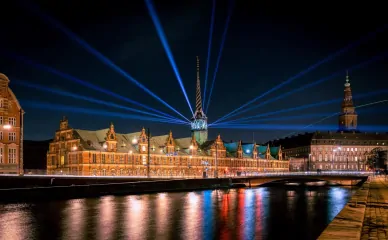
Copenhagen at night
In summer, tourists are lured by beach resorts. Despite a rather cold climate, there are more than 700 excellent beaches, most of which have obtained Blue Flag, the designation that means compliance with ecological standards and safety requirements. If you cannot be scared by refreshing water and winds, typical for Denmark, then visit the islands of Funen, Bornholm, and Rømø, the towns of Skagen and Aalborg, and Grenen spit. And even in the capital city, Copenhagen, there are several beaches well suitable for having rest.
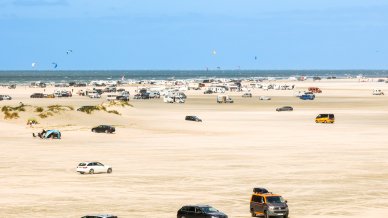
Lakolk Beach, Rømø, Denmark
Odense
Perhaps, every European has the fondest memories of this city where Hans Christian Andersen was born. Many generations have grown, reading his well-known The Little Mermaid, The Snow Queen, The Ugly Duckling, and 3,700 more beautiful and kind-hearted fairy tales.
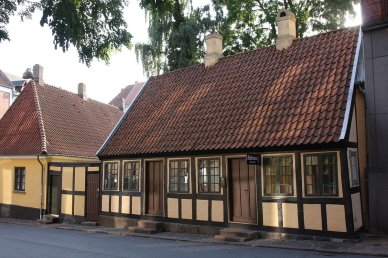
Childhood home of Hans Christian Andersen, Odense, Denmark
The house of Andersen has existed till modern time. The Danes take care of it and maintain it in perfect condition. The other must-see spot in Odense is the Hans Christian Andersen Museum.
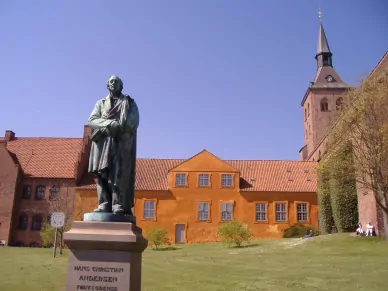
Hans Christian Andersen Museum
This city on the island of Funen is not only the homeland of fairy tales author. It is one of the oldest cities in Denmark where castles, cathedrals, the city palace, and many buildings constructed by the Vikings have been preserved.
St. Canute’s Cathedral and Egeskov Castle, built in the middle of the 18th century, are located in the city centre. The current castle owner has renovated it completely and established the museum of toys, an exhibition of rare vehicles, and a park for walking.
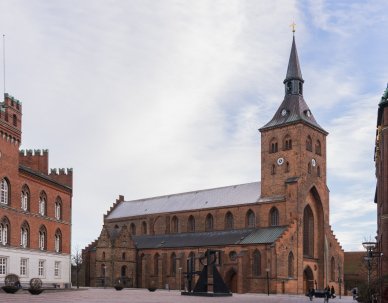
St. Canute’s Cathedral, Odense, Denmark
Odense Palace is the other enthralling place in Odense, but now it houses the municipal government.
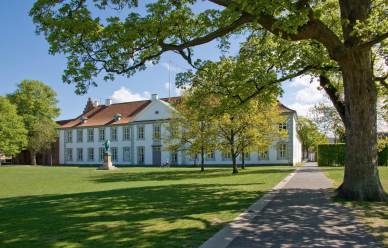
Odense Palace
Copenhagen
A thousand-year city is a jewel in the crown of Northern Europe and one of the most beautiful places on Earth. Gothic cathedrals, castles, royal residences, luxurious parks, modern offices of Danish and foreign companies, shopping arcades, and motorways with streams of cars have interwoven into a fantastic ornament.
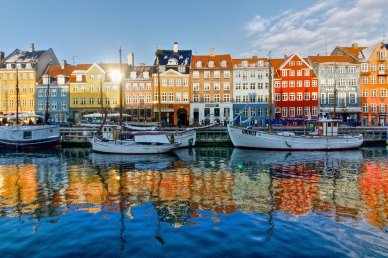
Copenhagen's Nyhavn neighbourhood, located on the banks of the canal
Start your walking tour across Copenhagen by exploring the royal residences — Amalienborg and Christianborg Palaces and Rosenborg Castle.
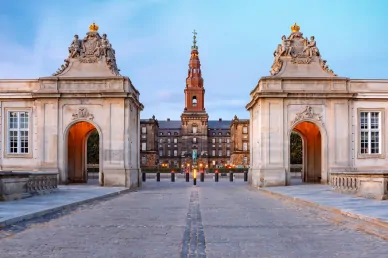
Christiansborg Palace, Copenhagen
Only the first one is still functioning as a residence of Queen Margrethe II. Amalienborg is a beautiful rococo-style monument of architecture built in the 18th century that maintains standards of elegance and grace. It consists of six mansions of the royal family, a manege, and a palace square where visitors may spectate the ceremony of changing of the Royal Life Guards protecting the residence.
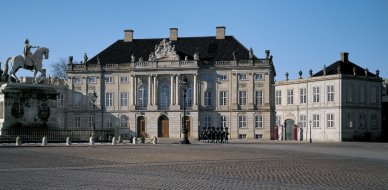
Amalienborg Palace, Copenhagen
The colonnade connects two palaces, the Frederik V statue, and the Amaliegarden.
Amalienborg became the royal residence in the 19th century after the fire in Christiansborg, the first Copenhagen palace. After the renovation, Amalienborg has housed the Danish Parliament called Folketing.
The Little Mermaid is an Andersen’s fairy tale statue by Edvard Eriksen. It appeared in 1913 as a sign of gratitude to August Bournonville, the author of a ballet about the fairy tale.
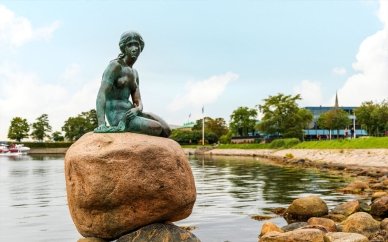
The Little Mermaid statue by Edvard Eriksen
Before its centenary and for the first time in its history, the statue had to leave Copenhagen to become a part of the Danish Pavillion in Expo 2010 Shanghai.
The only unlucky things that the Mermaid has undergone are the obsessive attention of tourists who constantly try to climb the statue to take a selfie and the compulsive aspiration of vandals to destroy or at least to spoil it. The Little Mermaid has been vandalised 15 times. It was poured with paint, beheaded, had its hand cut off, and defaced with obscene words. But every time, the residents of Copenhagen restored it as the memory of a great fairy tale author, Hans Christian Andersen, and a talented sculptor Edvard Eriksen.
At present, it has been relocated deep into the haven as a necessary measure of the local government. That has helped to save The Mermaid from the potential endeavours of vandals.
Food
Danish cuisine is simple but delicious and filling and not so extraordinary as the Swedish is.
Let us start with sandwiches. Though uncomplicated as it may seem, they have obtained a special status and further development in Denmark. A Danish sandwich is not just a slice of bread with butter, slices of cheese, and sausage.
It is a so-called multi-layer construction that combines various and sometimes mismatching ingredients.
Each layer is a separate dish. For example, the first slice of rye bread is spread with butter. Then the slices of cheese and sausage are put and covered with white bread, which, in its turn, is spread with liver pate and pieces of boiled tongue or raw smoked ham. The next layer is made of fish and seafood. And such a sequence is repeated at least five times.
Those constructions are called smørrebrøds and are eaten layer by layer using a knife and a fork. Garnish is a must too. As a rule, smørrebrøds are served with vegetable salads, fresh vegetables, sea kale, and anchovies. Thus, the sandwiches constitute a proper and healthy dinner.
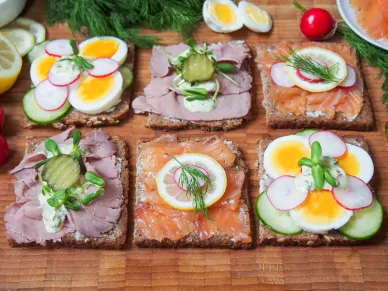
Smørrebrød (Danish open sandwiches)
The Danes eat a lot of potatoes, and the abundance of dishes is remarkable. The potatoes may be fried, baked, barbecued, boiled, stewed either separately or with meat, fish, or vegetables.
In Denmark, they like to eat meat and know the secrets of cooking it well. There are no religious taboos or prejudices related to its types, and you will be delighted tasting pork, beef, mutton, chicken, duck, or turkey at any Danish restaurant, cafe, or family dinner. Roast pork with red cabbage is one of the most favourite dishes as well as roast pork with apples and prunes.

Danish roast pork with prunes
Denmark is a maritime country, which means that fish and seafood are not rare things here. Exquisite salmon and tender trout, pike-perch, and northern pike are the delicacies worth eating when in Denmark.
Though there are not many desserts in Danish cuisine, they constitute a perfect ending to any dinner or supper. In Denmark, locals know the secrets of homemade pastry, like fluffy buns, called Vienna bread, or a currant-jam biscuit with whipped cream, a truly Danish dessert.
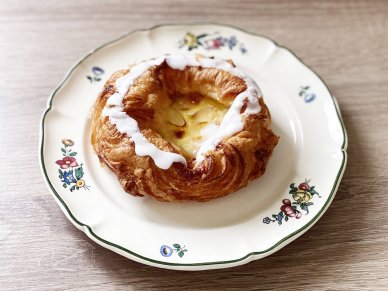
Wienerbrød (Vienna bread) - Traditional Danish Pastry
Coffee has been the number-one drink in Denmark among all non-alcoholic beverages. As a rule, the Danes drink it black, with cream or milk, with or without sugar.
This cold northern country is the place where people prefer hard spirits. Typically, the ancestors of rugged Vikings like to drink vodka. Beer is not less popular, for example, Carlsberg and Tuborg.
Beer lovers usually go to bodegas, or Danish pubs. Apart from the world-known beer sorts, local varieties, produced and sold only within the country, are worth trying too.
Påskeøl is a dark sweet beer with 6% ABV. It is traditionally drunk on Easter as well as light Hvidtøl with 2% ABV. On Christmas Eve, the Danes like to drink Nisseøl, Juleøl, and Julebryg, dark and light types with 5.6-6% ABV.
In addition, Lager, Guld, and Classic are widespread and cost €4 - €8.
Denmark is a cold country with a non-mild climate. It is hospitable, friendly, safe, and calm. Its nature is harsh, and the architecture has retained the memory of glorious times of the Vikings and the Crusades of Scandinavian knights. So if you are willing to delve into this atmosphere, do not hesitate to purchase a holiday tour.
FAQ
What is the proper name for Denmark?
The proper name for Denmark is the Kingdom of Denmark.
How big is the area of Denmark?
The area of Denmark is approximately 42,933 square kilometers.
What is the capital of Denmark?
The capital of Denmark is Copenhagen.
What is the population of Denmark?
The population of Denmark is about 5.8 million people.
Which language is mostly spoken in Denmark?
The primary language spoken in Denmark is Danish.
What is Denmark's main currency?
The main currency of Denmark is the Danish Krone (DKK).
What is the main religion of Denmark?
The main religion in Denmark is Christianity, specifically Lutheranism, with the Evangelical Lutheran Church being the state church.
What type of government runs Denmark?
Denmark is a constitutional monarchy with a parliamentary system of government.
Does Denmark have a good economy?
Yes, Denmark has a high-income economy, known for its high standard of living, comprehensive social welfare system, and a high level of income equality.
What is Denmark's biggest industry?
Major industries in Denmark include manufacturing, pharmaceuticals, maritime shipping, renewable energy, and information technology.
Is Denmark a member of the EU?
Yes, Denmark is a member of the European Union.
Is Denmark part of the Schengen?
Yes, Denmark is part of the Schengen Area.
Which countries can enter Denmark without a visa?
Citizens of EU countries, Schengen Area countries, and several other countries can enter Denmark without a visa for short stays. The list of visa-exempt countries can vary, so it's advisable to check the latest requirements.
What is Denmark most famous for?
Denmark is famous for its design and architecture, Viking history, Hans Christian Andersen's fairy tales, high quality of life, and being a pioneer in wind energy.
Is Denmark good for tourists?
Yes, Denmark is a popular tourist destination known for its beautiful landscapes, historic cities, rich cultural heritage, and modern design.
Is Denmark one of the safest countries?
Denmark is considered one of the safest countries in the world with low crime rates.
Is Denmark cheap or expensive?
Denmark is generally considered an expensive country, particularly in terms of living costs, dining, and accommodation.
Is Denmark nice to live in?
Denmark is often rated highly in terms of quality of life, with a strong social welfare system, emphasis on work-life balance, and a clean, safe environment.







